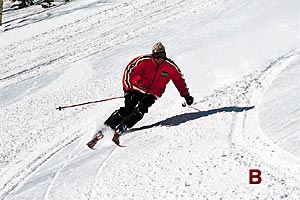Balancing Act: Side-to-Side Balance

A PROPER STANCE
STEVE Your stance says a lot about your side-to-side balance. Keeping your feet together looks pretty, but it’s inefficient (A). Widen your stance and you can use all four edges better. You can get your inside leg out of the way, and you can move better from one foot to the other (B).
STANCE DRILL
PHIL It’s unnatural for people to move their bodies downhill. But the key word in “downhill skiing” is downhill. Move downhill. We practice a one-ski drill we call “Feels Bad/Feels Good” (C-G). Turning on your outside ski (D, E and F) feels good. Turning and balancing on your inside ski (C and G) feels bad. To make it work you have to commit your body forward and downhill, crossing your body over the inside ski. Use this downhill body commitment in all your turns.
STEVE In ’83 I did this one-ski move unintentionally in a World Cup slalom in Garmisch. I’d won there before and was confident. But the tail of my right ski kept skidding out. So I skied most of the run only on my left, and ended up seventh. I later found out my right ski was partially broken. Feels Bad/Feels Good worked for me that day.
OUTSIDE SKI TO OUTSIDE SKI
STEVE Every left turn should be done on the right foot, and vice versa (H-I).
PHIL If you were running and you suddenly wanted to turn left, you wouldn’t plant your left foot¿you’d pivot off the right. Practice left turns balancing on your right foot (H), then switch, balancing on your left (I) as you turn right. Lift the inside ski off the snow to help you focus.
STEVE Your balance will be better, and you can get more edge by moving your inside leg out of the way (H). Your outside leg can flex more and work stronger.